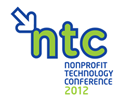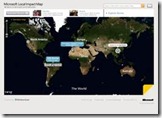#12NTC: Using Windows Azure to do good – and a live example
By Keith Thode, COO & CTO at AidMatrix
Today was the first full day of the 2012 Nonprofit Technology Conference (NTC), NTEN's annual gathering that brings together nonprofit professionals from around the world to learn, share, and explore the important role of technology for social good. I had the pleasure of serving with a fellow group of Social Sector Geeks and Cloud Technology experts to discuss the current status of Microsoft Windows Azure and its applications for those whose mission is to do good.
It was a packed house for our panel included Jane Meseck and James Rooney from Microsoft, Anna Jaeger from TechSoup and Darren David from Stimulant.
After an introduction from Jane and an overview of Windows Azure by James, Darren and Anna showcased the value of Microsoft Windows Azure and showcased the migration of Microsoft Citizenship’s Local Impact Map, built on Silverlight to run on Windows Azure.
|
This program provides visitors with an interactive map of Microsoft’s Citizenship programs around the world. The combination of the rich visual interface, the database of stories (including text, photos and videos), combined with the constantly maintained data streams of quality information provided by groups like TechSoup, provide an online tools that can be easily understood and used by the community. |
Batting cleanup for this crew, I had some pretty tough acts to follow in wrapping up the main content of our presentation time.
| I focused my comments on how Windows Azure helps Aidmatrix lower the cost and raise the quality of Humanitarian Aid Supply Chain Management and other SaaS (Software as a Service) products (like our Virtual Aid Drive™ pictured below), while at the same time lowering operational costs. In the Disaster Relief world, you don’t know when the need for your services will spike, or where in the world that spike will happen. |  |
With Windows Azure we are able to scale our applications, immediately, as well as have instances of our applications available hosted in parts of the Azure Cloud close to our users, no matter where in the world the event is taking place, thereby optimizing performance.
We are thankful to our partners Accenture, Avanade and Microsoft, each who have contributed greatly to our success migrating to Windows Azure. We have developed a significant capability with these partners in getting our Azure migration capabilities underway. At the conference I offered to let other NTEN members work with our team to leverage our corporate partner resources on the deeply discounted/donated basis we have arranged.
Ironically, the power and importance of the cloud was starkly proven immediately after our session. The Aidmatrix headquarters city – Dallas, Texas, was hit with a series of violent tornadoes just as I was finishing up my remarks. With our cloud-based infrastructure there was no disruption of the Aidmatrix applications or the accompanying support systems and staffing. With the storms still winding down as I write this, the Aidmatrix team in Dallas does not have to focus on recovering our operations, which means they are already hard at work assessing the needs in the community.
Keith Thode, COO & CTO at AidMatrix - Mr. Thode leads the daily operations of Aidmatrix, after serving in consulting and leadership roles in major technology firms like Accenture and i2 Technologies. As COO he governs business development, technology research and production, constituent relations, marketing and development, programming and systems management. He has been a founding force, building Aidmatrix since its foundation in 2001.

